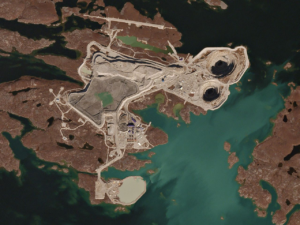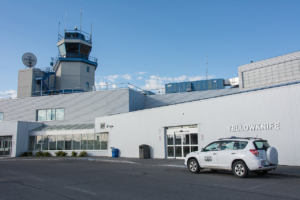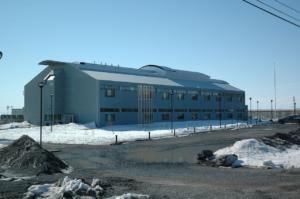
The Northwest Territories is a federal territory of Canada. At a land area of approximately 1,144,000 km2 (442,000 sq. mi) and its estimated population as of 2021, is 45,515 which is the second-largest and the most populous of the three territories in Northern Canada. Yellowknife is the capital, most populous community, and only city in the territory; its population was 19,569 as of the 2016 census. It became the territorial capital in 1967, following recommendations by the Carrothers Commission.
The Northwest Territories is bordered by Canada’s two other territories, Nunavut to the east and Yukon to the west, and by the provinces of British Columbia, Alberta, and Saskatchewan to the south, and may touch Manitoba to the southeast (historic surveys being uncertain) at a quadripoint including Nunavut and Saskatchewan.
The chamber of the Northwest Territories Legislative Building
The Northwest Territories extends for more than 1,300,000 km2 (500,000 sq. mi) and has a large climate variant from south to north. The southern part of the territory (most of the mainland portion) has a subarctic climate, while the islands and northern coast have a polar climate. Summers in the north are short and cool, featuring daytime highs of 14–17 degrees Celsius (57–63 °F) and lows of 1–5 degrees Celsius (34–41 °F). Winters are long and harsh, with daytime highs −20 to −25 °C (−4 to −13 °F) and lows −30 to −35 °C (−22 to −31 °F). The coldest nights typically reach −40 to −45 °C (−40 to −49 °F) each year. Extremes are common with summer highs in the south reaching 36 °C (97 °F) and lows reaching below 0 °C (32 °F). In winter in the south, it is not uncommon for the temperatures to reach −40 °C (−40 °F), but they can also reach the low teens during the day. In the north, temperatures can reach highs of 30 °C (86 °F), and lows into the low negatives. In winter in the north it is not uncommon for the temperatures to reach −50 °C (−58 °F) but they can also reach single digits during the day.
About half of the territory is above the tree line. There are not many trees in most of the eastern areas of the territory, or in the north islands.

Photo: Aerial view of the Diavik Diamond Mine in the North Slave Region
The Gross Domestic Product of the Northwest Territories was C$4.856 billion in 2017. The Northwest Territories has the highest per capita GDP of all provinces and territories in Canada.
The NWT’s geological resources include gold, diamonds, natural gas and petroleum. BP is the only oil company currently producing oil in the Territory. NWT diamonds are promoted as an alternative to purchasing blood diamonds. Two of the biggest mineral resource companies in the world, BHP and Rio Tinto mine many of their diamonds from the NWT.
During the winter, many international visitors go to Yellowknife to watch the auroras. Five areas managed by Parks Canada are situated within the territory. Aulavik National Park and Tuktut Nogait National Park are in the northern part of Northwest Territories. Portions of Wood Buffalo National Park are located within the Northwest Territories, although most of it is located in neighboring Alberta. Parks Canada also manages two park reserves, Nááts’ihch’oh National Park Reserve, and Nahanni National Park Reserve.

Photo: Yellowknife Airport, the largest airport in the territory
Yellowknife Airport is the largest airport in the territory in terms of aircraft movements and passengers. It is the gateway airport to other destinations within the Northwest Territories. As the airport of the territory capital, it is part of the National Airports System. It is the hub of multiple regional airlines. Major airlines serving destinations within Northwest Territories include Buffalo Airways, Canadian North, First Air, North-Wright Airways.
Yellowknife Transit is the public transportation agency in the city, and is the only transit system within the Northwest Territories.
Northwest Territories has nine numbered highways. The longest is the Mackenzie Highway, which stretches from the Alberta Highway 35’s northern terminus in the south at the Alberta – Northwest Territories border at the 60th parallel to Wrigley, Northwest Territories in the north. Ice roads and winter roads are also prominent and provide road access in winter to towns and mines which would otherwise be fly-in locations. Yellowknife Highway branches out from Mackenzie Highway and connects it to Yellowknife. Dempster Highway is the continuation of Klondike Highway. It starts just west of Dawson City, Yukon, and continues east for over 700 km (400 mi) to Inuvik.

Photo: Aurora College, Inuvik campus, Northwest Territories
Higher education in the Northwest Territories traces the development and expansion of higher education (also described as post-secondary or tertiary level education) in Canada’s Northwest Territories. In Canada, education is a provincial or territorial concern and there is no national regulation nor accrediting body. There is only one post-secondary institution in the NWT: Aurora College.
The territorial Department of Education, Culture and Employment is the government agency responsible for post-secondary education in the Northwest Territories. They have recognized 2 post-secondary institutions: Aurora College, which has core public funding, and formerly an Academy of Learning College. A third college, Collège nordique francophone, provides education to French-speaking residents of the Territories.
Source of the majority of Photos and Content of this page: Wikipedia
It is your duty in life to save your dream
AMEDEO MODIGLIANI